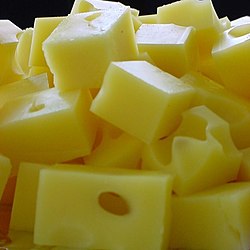Swiss cheese

Swiss cheese is a generic name in North America for several related varieties of cheese, mainly of North American manufacture, which resemble Emmental cheese, a yellow, medium-hard cheese that originated in the area around Emmental, in Switzerland. Some types of Swiss cheese have a distinctive appearance, as the blocks of the cheese are riddled with holes known as "eyes". Swiss cheese without eyes is known as "blind".[1] (The term is applied to cheeses of this style which have no connection with Switzerland, such as Jarlsberg cheese, which originates in Norway).
Production
[edit]Three types of bacteria are used in the production of Emmental cheese: Streptococcus salivarius subspecies thermophilus, Lactobacillus (Lactobacillus helveticus or Lactobacillus delbrueckii subspecies bulgaricus), and Propionibacterium (Propionibacterium freudenreichii subspecies shermani).[2] In a late stage of cheese production, the propionibacteria consume the lactic acid excreted by the other bacteria and release acetate, propionic acid, and carbon dioxide gas. The carbon dioxide slowly forms the bubbles that develop the "eyes".[3] The acetate and propionic acid give Swiss its nutty and sweet flavor.[4] Historically, the holes were seen as a sign of imperfection and cheese makers originally tried to avoid them by pressing during production. In modern times, the holes have become an identifier of the cheese.[5]
In general, the larger the eyes in a Swiss cheese, the more pronounced its flavor because a longer fermentation period gives the bacteria more time to act.[6] This poses a problem, however, because cheese with large eyes does not slice well and comes apart in mechanical slicers. As a result, industry regulators have limited the eye size by which Swiss cheese receives the Grade A stamp.[7]
Varieties
[edit]Baby Swiss and Lacy Swiss are two varieties of American Swiss cheeses. Both have small holes and a mild flavor. Baby Swiss is made from whole milk, and Lacy Swiss is made from low fat milk.[8] Baby Swiss was developed in the mid-1960s outside of Charm, Ohio, by the Guggisberg Cheese Company, owned by Alfred Guggisberg.[9]
Manufacturers
[edit]The largest manufacturer of Swiss cheese in the US is Brewster Dairy, located in Brewster, Ohio.[10][11]
See also
[edit]References
[edit]- ^ The Nibble. Cheese Glossary. See the asterisked footnote at the very bottom of that page Thenibble.com
- ^ Swiss Cheese Niche. Microbewiki.kenyon.edu
- ^ A bacterium used in the production of Emmental. Genoscope. 16 January 2008. Genoscope.cns.fr. See the "Activities in cheese" section.
- ^ Making Swiss Cheese. David B. Fankhauser, PhD. Professor of Biology and Chemistry. University of Cincinnati Clermont College
- ^ Scientific American Cheese Story August 2010 Pg 33
- ^ Swiss Cheese Niche. Microbewiki.kenyon.edu
- ^ Swiss Cheese. Professorshouse.com See the eighth paragraph.
- ^ Swiss Cheese. Recipetips.com
- ^ George Zimmermann, Carol Zimmermann (24 Nov 2009). Ohio Off the Beaten Path. Globe Pequot. p. 58.
- ^ Brewster Dairy. Brewstercheese.com
- ^ Sutherly, Ben (2001-10-05). "'Make it Swiss' to be Brewster's rallying cry in the marketplace". Retail Watch Archive. Quarne Publishing LLC. Retrieved January 22, 2007.
{{cite web}}: Cite has empty unknown parameters:|month=and|coauthors=(help)
External links
[edit]- Swiss Cheese Niche microbewiki.kenyon.edu
- Making Swiss Cheese biology.clc.uc.edu
